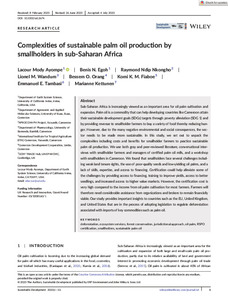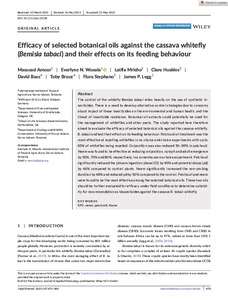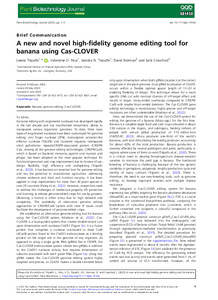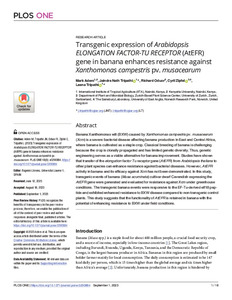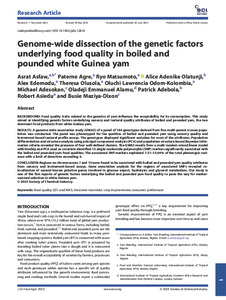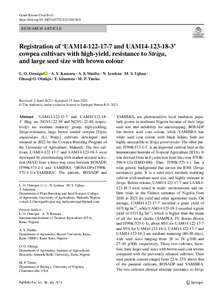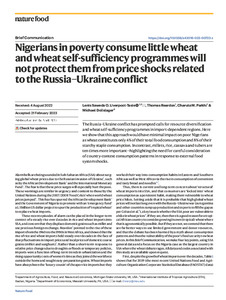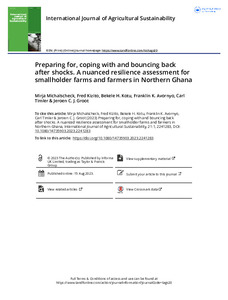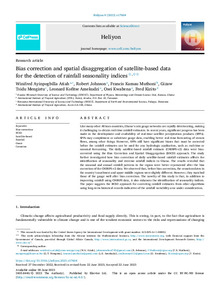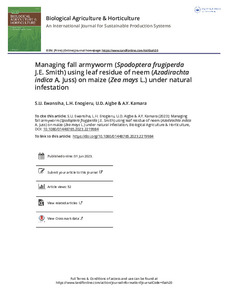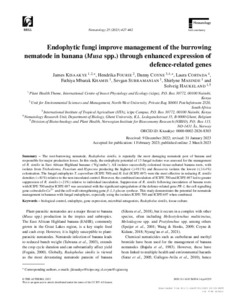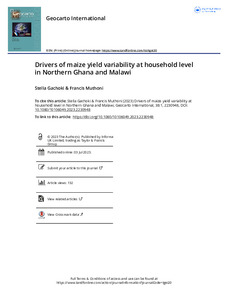Welcome to the International Institute of Tropical Agriculture Research Repository
Journal and Journal Articles: Recent submissions
Now showing items 161-180 of 5157
-
Complexities of sustainable palm oil production by smallholders in sub-Saharan Africa
(2023-07-17)Sub-Saharan Africa is increasingly viewed as an important area for oil palm cultivation and expansion. Palm oil is a commodity that can help developing countries like Cameroon attain their sustainable development goals (SDGs) targets through poverty alleviation (SDG 1) and by providing revenue to smallholder farmers to buy a variety of food thereby reducing hunger. However, due to the many negative environmental and social consequences, the sector needs to be made more sustainable. In this study, ... -
Status of yam (Dioscorea spp.) in the Democratic Republic of Congo
(2023-07-10)Yam is an important tuber crop with enormous potential to enhance rural sustenance and livelihood in DRC. However, studies to enhance its genetic improvement are very far from sufficient with only a handful of information available on the crop. Yam has been treated as an orphan crop compared to contemporary crops such as cassava and sweet potato which have adapted to different cropping systems and become widespread in production. The lack of research attention to address the major production ... -
Efficacy of selected botanical oils against the cassava whitefly (Bemisia tabaci) and their effects on its feeding behaviour
(2023-08)The control of the whitefly Bemisia tabaci relies heavily on the use of synthetic insecticides. There is a need to develop alternative control strategies due to concerns about impact of these insecticides on the environmental and human health, and the threat of insecticide resistance. Botanical oil extracts could potentially be used for the management of whiteflies and other pests. The study reported here therefore aimed to evaluate the efficacy of selected botanical oils against the cassava ... -
Influence of altitude as a proxy for temperature on key Musa pests and diseases in watershed areas of Burundi and Rwanda
(2023-03)Pests and diseases are key biotic constraints limiting banana production among smallholder farmers in Eastern and Central Africa. Climate changemay favour pest and disease development and further exacerbate the vulnerability of smallholder farming systems to biotic constraints. Information on effects of climate change on pests and pathogens of banana is required by policy makers and researchers in designing control strategies and adaptation plans. Since altitude is inversely related to temperature, ... -
Transgenic expression of Arabidopsis ELONGATION FACTOR-TU RECEPTOR (AtEFR) gene in banana enhances resistance againstXanthomonas campestris pv. musacearum
(2023-09-01)Banana Xanthomonas wilt (BXW) caused by Xanthomonas campestris pv. musacearum (Xcm) is a severe bacterial disease devastating banana production in East and Central Africa, where banana is cultivated as a staple crop. Classical breeding of banana is challenging because the crop is clonally propagated and has limited genetic diversity. Thus, genetic engineering serves as a viable alternative for banana improvement. Several studies have shown that interfamily transfer of the elongation factor Tu ... -
Advances in somatic embryogenesis of banana
(2023-07-01)The cultivation of bananas and plantains (Musa spp.) holds significant global economic importance, but faces numerous challenges, which may include diverse abiotic and biotic factors such as drought and various diseases caused by fungi, viruses, and bacteria. The genetic and asexual nature of cultivated banana cultivars makes them unattractive for improvement via traditional breeding. To overcome these constraints, modern biotechnological approaches like genetic modification and genome editing ... -
Genome-wide dissection of the genetic factors underlying food quality in boiled and pounded white Guinea yam
(2023-06-30)BACKGROUND Food quality traits related to the genetics of yam influence the acceptability for its consumption. This study aimed at identifying genetic factors underlying sensory and textural quality attributes of boiled and pounded yam, the two dominant food products from white Guinea yam. RESULTS A genome-wide association study (GWAS) of a panel of 184 genotypes derived from five multi-parent crosses population was conducted. The panel was phenotyped for the qualities of boiled and pounded yam ... -
Registration of ‘UAM14‑122‑17‑7 and UAM14‑123‑18‑3’ cowpea cultivars with high‑yield, resistance to Striga, and large seed size with brown colour
(2023-07-06)‘UAM14-122-17-7 and UAM14-123-18-3’ (Reg. no. NGVU-22-39 and NGVU-22-40, respectively) are medium maturity group, high-yielding, Striga-resistance, large brown seeded cowpea [Vigna unguiculata (L) Walp.] cultivars developed and released in 2022 by the Cowpea Breeding Program of the University of Agriculture, Makurdi. The two cultivars UAM14-122-17-7 and UAM14-123-18-3 were developed by crossbreeding with marker-assisted selection (MAS) from a three-way cross between BOSADP, IT99K-573-1-1 and YAMISRA ... -
Nigerians in poverty consume little wheat and wheat self-sufficiency programmes will not protect them from price shocks related to the Russia–Ukraine conflict
(2023-04-06)The Russia–Ukraine conflict has prompted calls for resource diversification and wheat self-sufficiency programmes in import-dependent regions. Here we show that this approach would have minimal impact on poor Nigerians as wheat constitutes only 4% of their total food consumption and 8% of their starchy staple consumption. In contrast, millets, rice, cassava and tubers are ten times more important—highlighting the need for careful consideration of country-context consumption patterns in response ... -
Convolutional neural network allows amylose content prediction in yam (Dioscorea alata L.) flour using near infrared spectroscopy
(2023-07-03)Background: Yam (Dioscorea alata L.) is the staple food of many populations in the intertropical zone where it is grown. The lack of phenotyping methods for tuber quality hinders the adoption of new genotypes from the breeding programs. Recently, near infrared spectroscopy (NIRS) has been used as a reliable tool to characterize the chemical composition of the yam tuber. However, it failed to predict the amylose content, although this trait is strongly involved in the quality of the product. Results: ... -
Assessment of the impact of crop management strategies on the yield of early-maturing maize varieties in the drylands of Niger Republic: Application of the DSSAT-CERES-Maize model
(2023-07-04)Maize is increasingly becoming important in Niger for use as food and feed. Production is however, faced with several abiotic and biotic constraints. Researchers have developed early-maturing maize varieties that are tolerant to drought, the parasitic weed Striga hermonthica and diseases that fit into the short growing production environment. The evaluation and deployment of these varieties would, however, involve costly and time-consuming field trials across the maize production zones of the ... -
Preparing for, coping with and bouncing back after shocks. A nuanced resilience assessment for smallholder farms and farmers in Northern Ghana
(2023)Smallholder farmers in Northern Ghana regularly face shocks, challenging the sustainability of their farms and livelihoods. Different farm households and household members may be differently affected and respond with different coping strategies. We combined whole-farm modelling and farmer consultations to investigate the vulnerability, buffer and adaptive capacity of three farm types in Northern Ghana towards severe climate, economic and social shocks. We further assessed intrahousehold differences ... -
Bias correction and spatial disaggregation of satellite-based data for the detection of rainfall seasonality indices
(2023-06-22)Like many other African countries, Ghana’s rain gauge networks are rapidly deteriorating, making it challenging to obtain real-time rainfall estimates. In recent years, real-time satellite precipitation products (SPPs) development and accessibility have advanced significantly. SPPs may compliment or substitute gauge data, enabling better real-time forecasting of streamflows among other things. SPPs, on the other hand, contain considerable biases that must be addressed before the rainfall predictions ... -
Bioinoculants and organic soil amendments affect nematode diversity in apple orchards
(2023-10)Nematodes with their versatile lifestyles provide a suitable lens to decipher the conditions of agroecosystems, but less is known about how they are affected by bioinoculants and organic soil amendments. To test if treatments modify the nematode community, we studied nematode communities in two different apple orchards under organic and integrated farming. Soil was treated with products containing arbuscular mycorrhizal fungi, bioeffectors, and organic amendments. The comparison between baseline ... -
Managing fall armyworm (Spodoptera frugiperda J.E. Smith) using leaf residue of neem (Azadirachta indica A. Juss) on maize (Zea mays L.) under natural infestation
(2023-06-01)Fall armyworm (Spodoptera frugiperda J.E. Smith) is a pest that has established across sub-Saharan Africa, capable of causing 100% yield loss in maize. Although aqueous extracts of neem (Azadirachta indica A. Juss) are being used to manage this pest, neem leaf residue may have added beneficial effects. This investigation was conducted during April–November 2020 at the Training and Research Farm, University of Benin, Nigeria, aiming to improve maize yields by using neem leaf residue for managing ... -
Endophytic fungi improve management of the burrowing nematode in banana (Musa spp.) through enhanced expression of defence-related genes
(2023-03-02)The root-burrowing nematode, Radopholus similis, is reputedly the most damaging nematode pest of banana and responsible for major production losses. In this study, the endophytic potential of 13 fungal isolates was assessed for the management of R. similis in East African Highland bananas (‘Ng’ombe’). All isolates successfully colonised tissue-cultured banana roots, with isolates from Trichoderma, Fusarium and Hypocrea producing the highest (⩾49.1%) and Beauveria isolates the lowest (⩽14.4%) ... -
Biocontrol-based strategies for improving soil health and managing plant-parasitic nematodes in coffee production
(2023-06-20)Coffee is an important commodity for Kenya, where production is steadily declining, despite a global rise in demand. Of the various constraints affecting production, plant-parasitic nematodes are a significant, but often overlooked, threat. As a perennial crop, treating plantations once infected with nematodes becomes difficult. The current study evaluated the drenching application of two biocontrol agents, Trichoderma asperellum and Purpureocillium lilacinum, for their nematode control efficacy, ... -
Drivers of maize yield variability at household level in northern Ghana and Malawi
(2023-07-03)Maize is a staple food, but productivity has stagnated due to limited access to advanced farming methods and knowledge. To promote sustainable agriculture, understanding the factors affecting maize yield at the farm level is crucial. This study used panel data on maize yield and agronomic practices in Northern Ghana and Malawi from 2014 to 2020. Satellite-based environmental variables were extracted at household locations, and Random Forest modeling was used to identify factors influencing maize ... -
Closing the yield gap of soybean (Glycine max (L.) Merril) in southern Africa: a case of Malawi, Zambia, and Mozambique.
(2023-07-07)Introduction: Smallholder farmers in Sub-Saharan Africa (SSA) are increasingly producing soybean for food, feed, cash, and soil fertility improvement. Yet, the difference between the smallholder farmers’ yield and either the attainable in research fields or the potential from crop models is wide. Reasons for the yield gap include low to nonapplication of appropriate fertilizers and inoculants, late planting, low plant populations, recycling seeds, etc. Methods: Here, we reviewed the literature on ...

